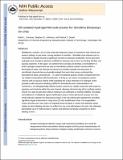Oil-Isolated Hydrogel Microstructures for Sensitive Bioassays On-Chip
Author(s)
Srinivas, Rathi L.; Johnson, Stephen D.; Doyle, Patrick S.
DownloadDoyle_Oil-isolated.pdf (513.1Kb)
PUBLISHER_POLICY
Publisher Policy
Article is made available in accordance with the publisher's policy and may be subject to US copyright law. Please refer to the publisher's site for terms of use.
Terms of use
Metadata
Show full item recordAbstract
Multiplexed, sensitive, and on-chip molecular diagnostic assays are essential in both clinical and research settings. In past work, running reactions in nanoliter- to femtoliter-sized volumes such as microwells or droplets has led to significant increases in detection sensitivities. At the same time, hydrogels have emerged as attractive scaffolds for bioassays due to their nonfouling, flexible, and aqueous properties. In this paper, we combine these concepts and develop a novel platform in which hydrogel compartments are used as individually confined reaction volumes within a fluorinated oil phase. We fabricate functional and versatile hydrogel microstructures in microfluidic channels that are physically isolated from each other using a surfactant-free fluorinated oil phase, generating picoliter- to nanoliter-sized immobilized aqueous reaction compartments that are readily functionalized with biomolecules. In doing so, we achieve monodisperse reaction volumes with an aqueous interior while exploiting the unique chemistry of a hydrogel, which provides a solid and porous binding scaffold for biomolecules and is impenetrable to oil. Furthermore, our lithographically defined reaction volumes are readily customized with respect to geometry and chemistry within the same channel, allowing rational tuning of the confined reaction volume on a post-to-post basis without needing to use surfactants to maintain stability. We design and implement a multiplexed signal amplification assay in which gel-bound enzymes turn over small molecule substrate into fluorescent product in the oil-confined gel compartment, providing significant signal enhancement. Using short (20 min) amplification times, the encapsulation scheme provides up to 2 orders of magnitude boost of signal in nucleic acid detection assays relative to direct labeling and does not suffer from any cross-talk between the posts. We ultimately demonstrate up to 57-fold increase in nucleic acid detection sensitivity compared to a direct labeling scheme.
Date issued
2013-11Department
Massachusetts Institute of Technology. Department of Chemical EngineeringJournal
Analytical Chemistry
Publisher
American Chemical Society (ACS)
Citation
Srinivas, Rathi L., Stephen D. Johnson, and Patrick S. Doyle. “Oil-Isolated Hydrogel Microstructures for Sensitive Bioassays On-Chip.” Anal. Chem. 85, no. 24 (December 17, 2013): 12099–12107.
Version: Author's final manuscript
ISSN
0003-2700
1520-6882